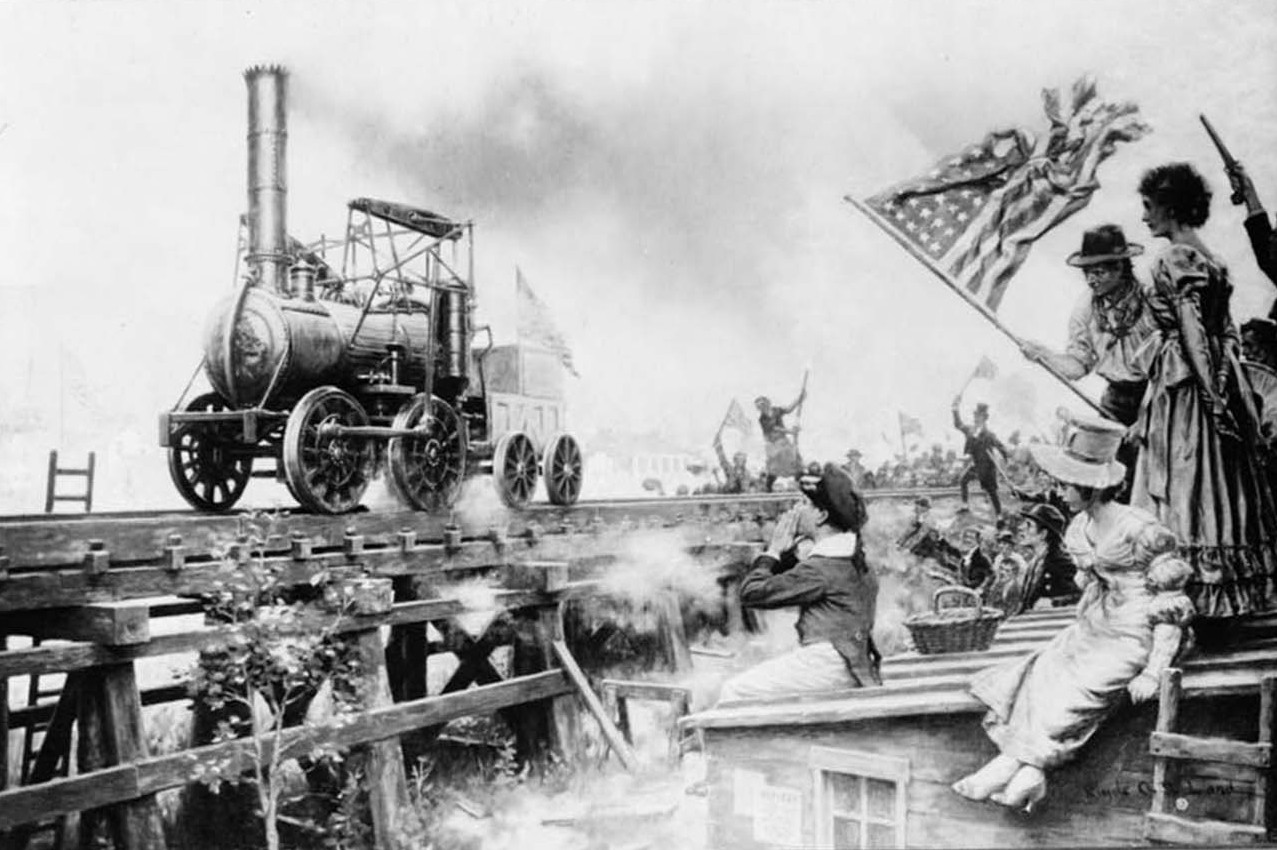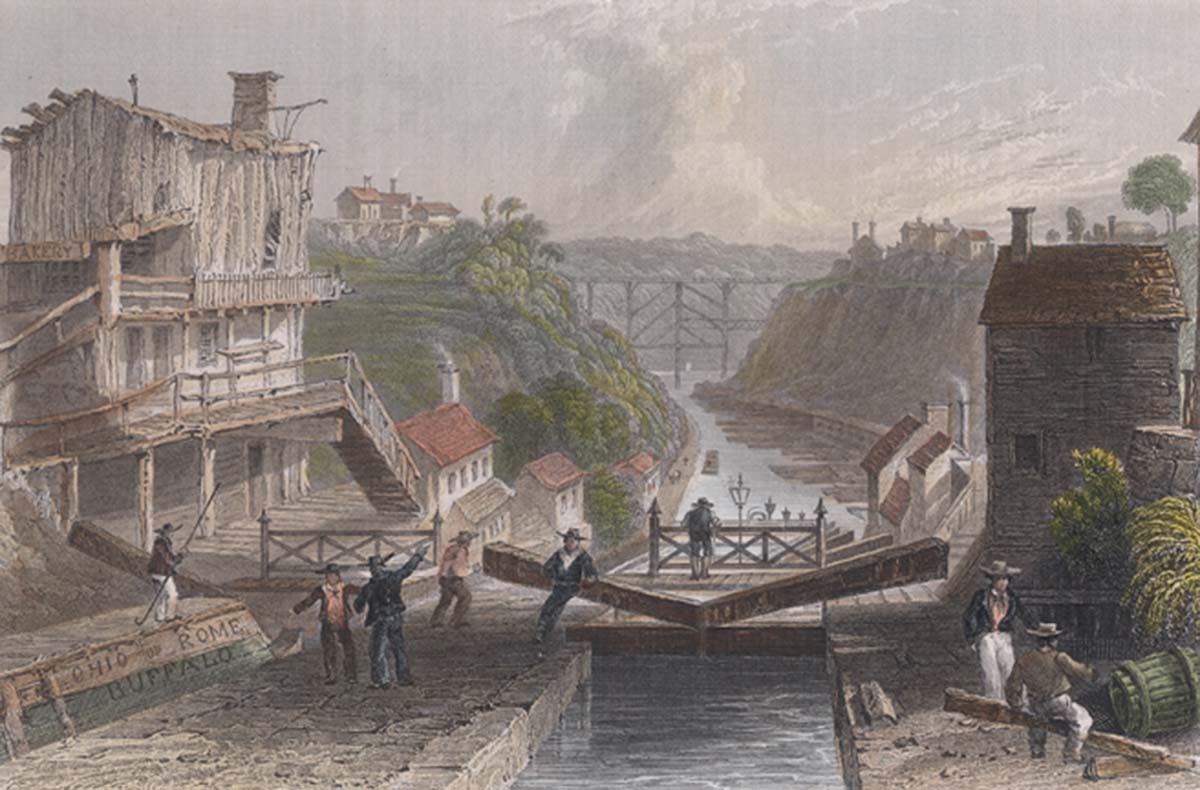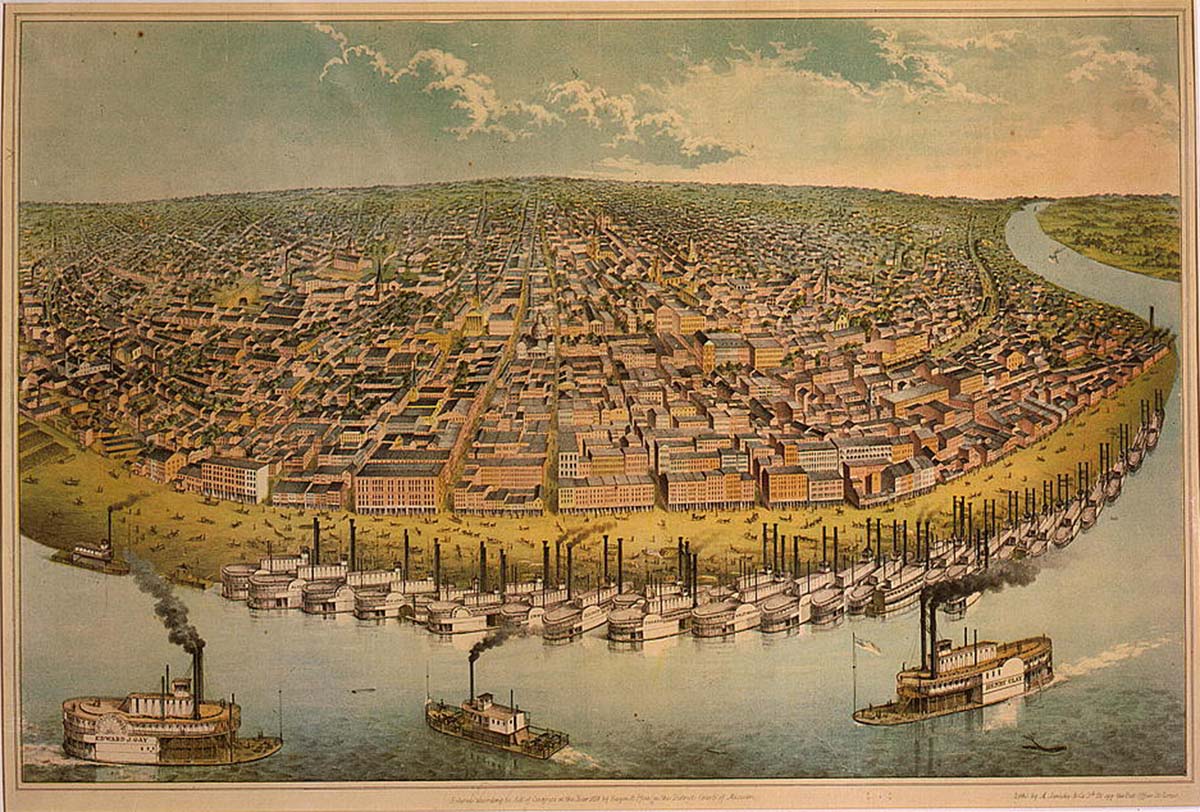28 Early Republic Economic Development
The growth of the American economy reshaped American life in the decades before the Civil War. Americans increasingly produced goods for sale, not for consumption. With a larger exchange network connected by improved transportations, the introduction of labor-saving technology, and the separation of the public and domestic spheres, the market revolution fulfilled the revolutionary generation’s expectations of progress but introduced troubling new trends. Class conflict, child labor, accelerated immigration, and the expansion of slavery followed. These strains required new family arrangements and forged new urban cultures.
American commerce had proceeded haltingly during the eighteenth century. American farmers increasingly exported foodstuffs to Europe as the French Revolutionary Wars devastated the continent between 1793 and 1815. America’s exports rose in value from $20.2 million in 1790 to $108.3 million by 1807. But while exports rose, exorbitant internal transportation costs hindered substantial economic development within the United States. In 1816, for instance, $9 could move one ton of goods across the Atlantic Ocean, but only 30 miles across land. An 1816 Senate Committee Report lamented that “the price of land carriage is too great” to allow the profitable production of American manufactures. But in the wake of the War of 1812, Americans rushed to build a new national infrastructure, new networks of roads, canals, and railroads. In his 1815 annual message to Congress, President James Madison stressed “the great importance of establishing throughout our country the roads and canals which can best be executed under national authority.” State governments continued to sponsor the greatest improvements in American transportation, but the federal government’s annual expenditures on internal improvements climbed to a yearly average of $1,323,000 by Andrew Jackson’s presidency.

State legislatures meanwhile pumped capital into the economy by chartering banks and the number of state-chartered banks skyrocketed from 1 in 1783, 266 in 1820, 702 in 1840, to 1,371 in 1860. European capital also helped to build American infrastructure. By 1844, one British traveler declared that “the prosperity of America, her railroads, canals, steam navigation, and banks, are the fruit of English capital.”
Economic growth, however, proceeded unevenly. Depressions devastated the economy in 1819, 1837, and 1857. Each followed rampant speculation—bubbles—in various commodities: land in 1819, land and slaves in 1837, and railroad bonds in 1857. But Americans refused to blame the logic of their new commercial system for these depressions. Instead, they kept pushing “to get forward.”
The so-called “Transportation Revolution” opened for Americans the vast lands west of the Appalachian Mountains. In 1810, for instance, before the rapid explosion of American infrastructure, Margaret Dwight left New Haven, Connecticut, in a wagon headed for Ohio Territory. Her trip was less than 500 miles but took six full weeks to complete. The journey was a terrible ordeal, she said. The roads were “so rocky & so gullied as to be almost impassable.” Ten days into the journey, at Bethlehem, Pennsylvania, Dwight said “it appeared to me that we had come to the end of the habitable part of the globe.” She finally concluded that “the reason so few are willing to return from the Western country, is not that the country is so good, but because the journey is so bad.” Nineteen years later, in 1829, English traveler Frances Trollope made the reverse journey across the Allegheny Mountains from Cincinnati to the east coast. At Wheeling, Virginia, her coach encountered the National Road, the first federally funded interstate infrastructure project. The road was smooth and her journey across the Alleghenies was a scenic delight. “I really can hardly conceive a higher enjoyment than a botanical tour among the Alleghany Mountains,” she declared. The ninety miles of National Road was to her “a garden.”

If the two decades between Margaret Dwight’s and Frances Trollope’s journeys transformed the young nation, the pace of change only accelerated in the following years. If a transportation revolution began with improved road networks, it soon incorporated even greater improvements in the ways people and goods moved across the landscape.
New York State completed the Erie Canal in 1825. The 350 mile-long manmade waterway linked the Great Lakes with the Hudson River—and thereby to the Atlantic ocean. Soon crops grown in the Great Lakes region were carried by water to eastern cities, and goods from emerging eastern factories made the reverse journey to midwestern farmers. The success of New York’s “artificial river” launched a canal-building boom. By 1840 Ohio created two navigable, all-water links from Lake Erie to the Ohio River.
Robert Fulton established the first commercial steam boat service up and down the Hudson River in New York in 1807. Soon thereafter steamboats filled the waters of the Mississippi and Ohio rivers. Downstream-only routes became watery two-way highways. By 1830, more than 200 steamboats moved up and down western rivers.
The United States’ first long-distance rail line launched from Maryland in 1827. Baltimore’s city government and the state government of Maryland provided half the start-up funds for the new Baltimore & Ohio (B&O) Rail Road Company. The B&O’s founders imagined the line as a means to funnel the agricultural products of the trans-Appalachian West to an outlet on the Chesapeake Bay. Similar motivations led citizens in Philadelphia, Boston, New York City, and Charleston, South Carolina to launch their own rail lines. State and local governments provided the means for the bulk of this initial wave of railroad construction, but economic collapse following the Panic of 1837 made governments wary of such investments. Government supports continued throughout the century, but decades later the public origins of railroads were all but forgotten and the railroad corporation became the most visible embodiment of corporate capitalism.
By 1860 Americans laid more than 30,000 miles of railroads. The ensuing web of rail, roads, and canals meant that few farmers in the Northeast or Midwest had trouble getting goods to urban markets. Railroad development was slower in the South, but there a combination of rail lines and navigable rivers meant that few cotton planters struggled to transport their products to textile mills in the Northeast and in England.
Such internal improvements not only spread goods, they spread information. The “transportation revolution” was followed by a “communications revolution.” The telegraph redefined the limits of human communication. By 1843 Samuel Morse persuaded Congress to fund a forty-mile telegraph line stretching from Washington, D.C. to Baltimore. Within a few short years, during the Mexican-American War, telegraph lines carried news of battlefield events to eastern newspapers within days, in stark contrast to the War of 1812, when the Battle of New Orleans took place nearly two full weeks after Britain and the United States had signed a peace treaty.
The consequences of the transportation and communication revolutions reshaped the lives of Americans. Farmers who previously produced crops mostly for their own family now turned to the market. They earned cash for what they had previously consumed; the purchased the goods they had previously made or went without. Market-based farmers soon accessed credit through by eastern banks, which provided them with both the opportunity to expand their enterprise but left them prone before the risk of catastrophic failure wrought by distant and impersonal market forces. In the Northeast and Midwest, where farm labor was ever in short supply, ambitious farmers invested in new technologies that promised to increase the productivity of the limited labor supply. The years between 1815 and 1850 witnessed an explosion of patents on agricultural technologies. The most famous of these, perhaps, was Cyrus McCormick’s horse-drawn mechanical reaper, which partially mechanized wheat harvesting, and John Deere’s steel-bladed plough, which more easily allowed for the conversion of unbroken ground into fertile farmland.

Most visibly, the market revolution encouraged the growth of cities reshaped the lives of urban workers. In 1820, only two cities in the United States—New York and Philadelphia—had over 100,000 inhabitants. By 1850, six American cities met that threshold, including Chicago, which had been founded fewer than two decades earlier. New technology and infrastructure paved the way for such growth. The Erie Canal captured the bulk of the trade emerging from the Great Lakes region, securing New York City’s position as the nation’s largest and most economically important city. The steamboat turned St. Louis and Cincinnati into centers of trade, and Chicago rose as it became the railroad hub of the western Great Lakes and Great Plains regions. The geographic center of the nation shifted westward. The development of stream power and the exploitation of Pennsylvania coalfields shifted the locus of American manufacturing. By the 1830s, for instance, New England was losing its competitive advantage as new sources and locations of power opened up in other regions.
Meanwhile, the cash economy eclipsed the old, local, informal systems of barter and trade. Income became the measure of economic worth. Productivity and efficiencies paled before the measure of income. Cash facilitated new impersonal economic relationships and formalized new means of production. Young workers might simply earn wages, for instance, rather than receiving room and board and training as part of apprenticeships. Moreover, a new form of economic organization appeared: the business corporation.
To protect the fortunes and liabilities of entrepreneurs who invested in early industrial endeavors, states offered the privileges of incorporation. A corporate charter allowed investors and directors to avoid personal liability for company debts. The legal status of incorporation had been designed to confer privileges to organizations embarking upon expensive projects explicitly designed for the public good, such as universities, municipalities, and major public works projects. The business corporation was something new. Many Americans distrusted these new, impersonal business organizations whose officers lacked personal responsibility while nevertheless carrying legal rights. Many wanted limits. Thomas Jefferson himself wrote in 1816 that “I hope we shall crush in its birth the aristocracy of our monied corporations which dare already to challenge our government to a trial of strength, and bid defiance to the laws of our country.” But in Dartmouth v. Woodward (1819) the Supreme Court upheld the rights of private corporations when it denied the government of New Hampshire’s attempt to reorganize Dartmouth College on behalf of the common good. Still, suspicions remained. A group of journeymen cordwainers in New Jersey publically declared in 1835 that they “entirely disapprov[ed] of the incorporation of Companies, for carrying on manual mechanical business, inasmuch as we believe their tendency is to eventuate and produce monopolies, thereby crippling the energies of individual enterprise.”

